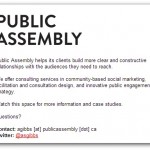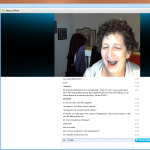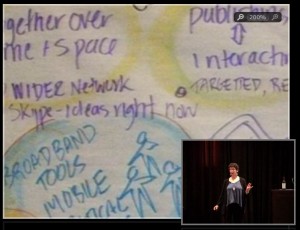 Note: this is an update of an older article I wrote on online facilitation. You might say, this has been steeping for a while. 😉 I have both updated it, and tweaked it to meet the needs of the Project Community Course at the Hague Technical University.
Note: this is an update of an older article I wrote on online facilitation. You might say, this has been steeping for a while. 😉 I have both updated it, and tweaked it to meet the needs of the Project Community Course at the Hague Technical University.
Nancy White, Full Circle Associates
For CommProj12
October, 2012
In your teams you have looked at various online communities and networks that might contribute to an innovative and open design process. You have determined purpose or focus, you have identified some exemplar communities or networks in order to examine them more closely and have analyzed what activities they support, and how technology assists in that process. But in the end, we are dealing with human beings, so we need to also attend to the social practices. How do people interact? What norms, agreements or rules shape this interaction? How do individuals facilitate this interaction?
To begin this exploration, lets think about a few things.
What is Online Facilitation?
Online group interactions do not always “happen” spontaneously. They require care and nurturing: facilitation. The core of facilitation is to serve the group and assist it in reaching its goals or purpose. Some describe this role as a gardener, a conductor, the distributed leadership of jazz improvisers, a teacher, or an innkeeper. It can be this and more. Levitt, Popkin and Hatch, in their article “Building Online Communities for High Profile Internet Sites” wrote, “Communities are organic in nature and site owners can’t make them successful or force them to grow. As site owner can only provide the fertile ground on which a community may grow, and then provide some gentle guidance to help the group thrive. Much of the challenge in fostering an online community is social, rather than technical.”
Facilitation is a balance between functions that enhance the environment and content, create openness and opportunity, and functions that protect the members from harassment. It involves the sacred rituals around freedom of individual expression while preserving something of “the common good.” It is juggling, tight-rope walking, often without a net. The distance to the hard cold ground varies with the community or group goals.
The clearer the purpose, the easier it is to craft the facilitation approach. Purpose provides participants and facilitators expectations upon which they can base their actions. Facilitators foster member interaction, provide stimulating material for conversations, keep the space cleaned up and help hold the members accountable to the stated community guidelines, rules or norms. They pass on community history and rituals. They “hold the space” for the members. Perhaps more importantly, hosts often help community members do these things for themselves. Without someone taking on these responsibilities, it is easy for an online space to get sidetracked, disrupted or simply abandoned. For more specifics on online facilitation, see Some Considerations for Facilitating Online Interaction.
Online facilitators’ most important skills are as a skilled group facilitator and genuine, authentic communicator. In a text environment, that means people at ease reading and writing with care and clarity. While these ideas were fairly unusual in the mid 1990’s and the early online communities, they are fairly common now.
Being an online facilitator benefits from our offline facilitation experience. Here is something I wrote on my blog about this connection:
My early geographical community leadership work found legs when I learned things like mirroring to better hear and understand what others were saying – usually with a small gesture that started with eye contact, leaning in to listen, and paraphrasing to work towards understanding. When I first started facilitating online around 1997, the simple act of welcoming and reciprocating opened up the magic of text based asynchronous conversation. As I returned to more face to face meeting facilitation, again the gestures of showing that I was listening, of helping make the act of “being heard, seen and loved” (a central teaching of the Dalai Lama) central to group interaction proved powerful. More powerful than any method or tool.#
Who is the Facilitator?
The online facilitator can be the convenor, online community owner, or someone designated by the community owner. The role may evolve within a group. It is usually preset for large commercially oriented communities, such as customer communities and the role is often called the “community manager.”
Small communities may have just one, while large online spaces with many spaces and topics may use teams. Facilitators may be unpaid volunteers in the social communities, where facilitators in online work groups often draw from the team. Facilitators may be a team leader or outside contractor.
In some cases, communities and groups self-facilitate. They have enough awareness of the process issues and sufficient skills to spread these duties across the membership.
What Specifically do Online Facilitators Do?
Facilitators in offline situations have certain established roles providing leadership, focus, stimulation for group interaction, support, team building, refereeing, dealing with problems, timekeeping, responding to member feedback and group regulation. These may also be needed online, but there are also differences in text-based and synchronous web interactions. Communication has a few more challenges, plus there are the advantages and disadvantages of electronic tools. Social presence manifests in more subtle and layered ways, like the layers of an onion. This is further complicated by the way our identities can and are expressed online across a variety of sites and media. (See more about the comparison between online and offline facilitation here.)
Facilitator approaches depend on the nature of the community. Some communities, such as conversational, text based “salon type” communities, need a very low-key “host.” This is commonly seen in special interest and hobby communities. Some need very clear and rapid responses, or distinct leadership qualities such as in help and support communities. Teams online reflect many offline team leader characteristics. Some have very specific, named roles such as in gaming communities (World of Warcraft guild leaders, for example.) Others need facilitators to help raise the overall skill level of the community to facilitate itself.
In general, there are four pillars of online facilitation:
- Understanding of group facilitation as it occurs face to face and online. This includes understanding issues around group size, differentiating convergent and divergent processes and having a range of facilitation methods to chose from.
- Knowledgeable about design. Ideally, facilitators are involved in the conceptualization, design and implementation of the online space to ensure that group member needs are accounted for. They participate in pre-assessment and planning.
- Grounded in the group’s purpose with full understanding. Facilitators understand the “why and what for” of an online group can convey it clearly to group members.
- Prepared with tools and technical practices. Facilitators have enough knowledge and comfort with technology to use it, to diagnose problems of others’ use of the tools and an ability to coach others to use the tools.
Facilitators use their group facilitation skills to enable the group to meet it’s goals. This involves a group of processes which often include:
- Entry and engagement processes which help members become active participants. This can include both technical and social orientation or “onboarding.”
- Supporting sociability, relationship and trust building – particularly important for teams and bounded groups or where there is a lot of interdependent tasks and interactions.
- Constructing, adapting and modeling norms, agreements and accountability. Again, for more bounded and long term groups, this is important. It is a much lighter touch for short interactions or very open groups.
- Support discussion and dialog (foster communication). Understanding conversational dynamics, the power of rephrasing, asking good questions and surfacing meaning moves conversation forward.
- Support divergent, convergent and task-oriented group processes (help get work done)
- Anticipate and work with conflict and abrasion to both allow emergence of new ideas and protect people from harassment
- Work with full understanding of diversity in learning style, culture and personal styles
- Understand and make visible group participation cycles and “rituals” in the online environment.
- Summarize, harvest, weave and support appropriate content and connections
- Provide basic help as needed with the tools
- Ensure the space is kept “tidy” and navigable.
Variations on the Facilitator Role
To get a sense of some of the variety of facilitator roles, you may wish to read first hand from Hosts on Hosting. As you consider your role compared to theirs, you will probably find that you are doing a combination job, utilizing skills from all areas. And it varies over time as a community matures and members start to take on various roles. People have created many metaphors to describe the role of online facilitator that help us visualize the roles. Here are some examples along with links to resources:
The Social Host
The social host or “host as innkeeper” is the most well-known online facilitation model originating out of long time discussion communities like The Well, Electric Minds (note, this page seems to be rarely up anymore) and Salon Table Talk. Any person who has created a group on Facebook will recognize this approach. This is the most familiar role, but is not the ONLY role. As a dinner host brings together the elements of a successful party, a social host helps create an environment where the members feel comfortable to participate. Part conversationalist, part counselor, part role model and sometimes even part bouncer. They are also usually part of the conversation.
Applications include:
- social, conversational communities
- helping entrants feel “at home” and acclimated in work groups and communities of practice
- customer service
Key skills include:
- greeter
- social skills
- conversation stimulator (content, style, process)
- sometimes utilizes a persona or a “character.”
- conflict resolution (particularly in open, public online communities)
Links to articles on this style of hosting, as well as some hosts on hosting who play the role with panache.
The Team or Project Manager
In communities with a strong task, work orientation or subject focus, the team manager pays attention to adherence to focus, timelines, task lists, commitments and process. This can be a leadership and/or support role. This can be aided by the use of static web pages to organize information, the combined use of linear and threaded conferencing space, and the regular use of summaries and reviews. Skills include traditional project management and organizing.
Applications include:
- Virtual work groups and teams
- Online events (especially time-delimited)
Key skills include:
- traditional project management skills
- writing and summarization skills
- technical skills such as HTML to create information and summaries with visual impact
- ability to abstract information and process it for the group
Links to articles
The Cybrarian
Cybrarians represent the gift of knowledge and information. They are “topical” experts. Cybrarians help members find information internally and externally of the community. They organize information and make it accessible. And they stimulate interaction with the introduction of or pointer to new and relevant information.
Applications include:
- Virtual workgroups and teams
- Topic-oriented conversation communities
- Help desks
- Distance learning settings
Key skills include:
- web-savvy research
- strong organizational bent
- love of learning and information
The Community of Practice (CoP) Facilitator (or Coordinator)
CoPs share and build knowledge around a practice. Part of this process is being a group – having identity and reputation, being able to have agreements and some sense of accountability to the group. Facilitating CoPs online can focus on some of these “sociability” and relationship issues. This includes helping members get to know each other, articulating and making visible agreements, and watching/nurturing group dynamics. Skills include group facilitation and a working knowledge of CoPs.
Applications include:
- Internal formal and informal CoPs
- Cross organizational CoPs
- Formal and informal learning communities.
Key skills include:
Links to articles
The Help Desk/Customer Service
In customer support communities and in online interaction spaces where there is an ongoing influx of new members, there is often repeated need for simple help pointers on using the software or understanding the community purpose and guidelines.
Applications include:
- E-Commerce and service organizations
- Larger communities where new folks need help with the software
Key skills include:
- technical understanding/patience
- clear communication skills
The Referee
Good cop or bad cop, this is the role of bringing attention to and/or enforcing community norms, rules and procedures. Referees help the community regulate, protect members and deal with problems. For example, if a community has a policy of no posting of advertising, the host has the job of deleting offending posts and asking the poster to refrain from posting ads. The clearer the rules, the easier the job. Likewise, where there are no clear rules, this job is often perceived as authoritarian and arbitrary. Referees are often not “regular members” who are “just part of the conversation,” but a role apart. These tend to be employees of online community sites and have rather small facilitative impact on a group.
Applications include:
- social, conversational communities
- topic oriented discussion groups
- customer service
- workgroups
Key skills include:
- thick skin and a slow fuse
- Internet experience
- familiarity with common netiquette
Links to articles
The Janitor
It can get messy in cyberspace, as we leave our words in conferences and topics. The Janitor tidies up forgotten topics by freezing and archiving, and redirects activity if it is in the wrong area.
Applications include:
- any community with multiple spaces
- high volume spaces
Key skills include:
- familiarity with software
- attention to detail
The Network Weaver
Today we have many online forms that aren’t bounded and can’t be simply managed or controlled. They represent the possibility of webs or relationships to serve a purpose. The skills in this context are more about noticing patterns, opportunities and connecting people.
Applications include:
- Interactions in open networks like Twitter and Facebook
- Working across group and organizational boundaries (which is very common in the international development context.)
Key skills include:
- Ability to scan and see patterns between people and across content
- Keeps one own social network in mind and has practices to keep tabs on it
- Understands use of aggregation tools, tags, etc.
Links to articles:
In the end, why is online facilitation important or useful?
There are hundreds of reasons for online facilitation and they are context dependent. But there are some general patterns that have shown up in my work across various contexts demonstrating the value of online facilitation. Here are a few examples.
1. Connecting people matters. When we facilitate in an innovation or learning context, connection between people accelerates learning. It can also turn traditional structures on their heads and unleash new possibilities.
In 2000 I got involved in a small grant project in the Southern Caucasus, run by a small Vermont based nonprofit seeking to connect small business owners in three post Soviet countries using the Internet. In three countries with less than 10% internet penetration at the time. Two of whom were (and are still) at war with each other. As you might guess, few of the entrepreneurs benefited, but the three country managers connected with each other in new ways, giving sufficient support to learn new things quickly and more easily than before, support each other in taking risks and rapidly iterating towards some amazing innovations. Being connected changed their leadership experiences and increased their learning more rapidly than a typical “country program manager” might. They all went all to lead amazing programs there and in other places. At the same time their home office got a little freaked out… and they actually suggested (with some humor) that I had provoked a cult. But what turned things around was that their funders were so impressed, the home office eventually came around. It turned things upside down for a while and made things uncomfortable, but in the end it cause a fundamental and productive change.
2. Small things matter. The practices of connecting for design, innovation, production, and support abound in the era of social media. We have more opportunity than time or attention. So it is interesting to observe that big changes often turn on little actions. Someone introducing two people who might share an interest. A small, sincere thank you for a contribution to a network. A shift in web meeting scheduling to better accommodate diverse time zones.
I was at a gathering of one of my core international networks some years back and we closed the meeting by “going round the circle” to briefly share what we were learning. A woman I had just met said something about appreciating learning from me. I looked across this circle and thought “who is this woman?” Now that woman is one of my key learning and working partners, even though we are half a world apart. If she had not spoken up the connection would not have happened.
3. Jumping boundaries shines new light on ideation, design, creation and distribution. The online world gives us access to people and ideas that are far more diverse than those in our immediate geographic surroundings. We can see other ideas, practices, opinions, strengths, weaknesses and even entire perspectives that enrich and expand our thinking. This unleashes immense possibilities. It can change our practices. It can change our lives.
Years ago I used to doodle to endure long, bureaucratic meetings that were part of my job. People started asking to have those doodles, as they reflected something in those meetings that resonated for them. Years later I have begun to do graphic facilitation – the use of visuals in group process. By stepping into a new practice – literally and mentally, it has changed the way I connect with others and make sense of my interactions with them. Changing modes has changed my learning. This shows up again and again as I work in new domains and parts of the world. Diversity enriches our learning.
What next? Here are some questions for you to consider this week
- What are particular online facilitation patterns or practices that might be useful in each design phase?
- What might you we looking for in our exemplar communities and networks?
- How do we look for evidence of facilitation? How do we evaluate it?
- Some of you have quite a bit of experience on social networks. What facilitation knowledge and skills do you have? How have you used them fruitfully?
Background, References and Related Resources that I’ve Written or Posted over the years
Online Facilitation Overview – Google Docs.
 Too great NOT to share this from Amanda Gibbs…
Too great NOT to share this from Amanda Gibbs…

